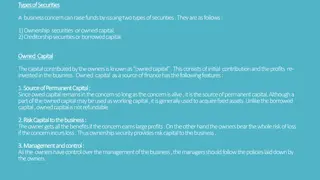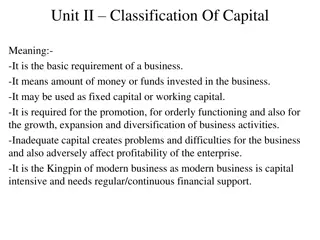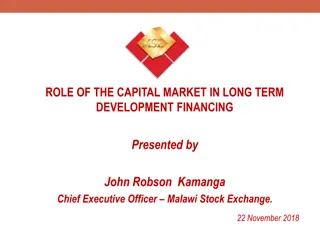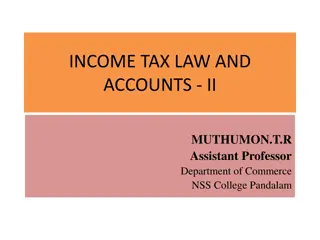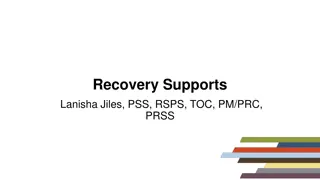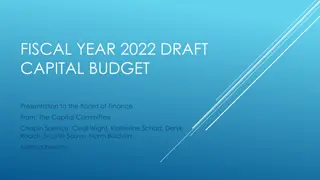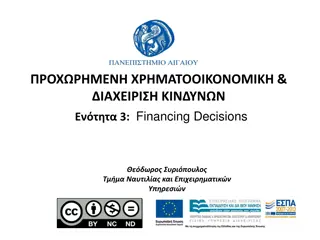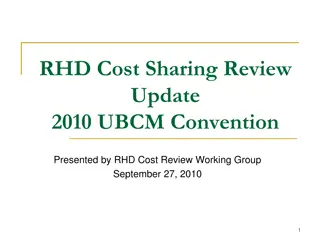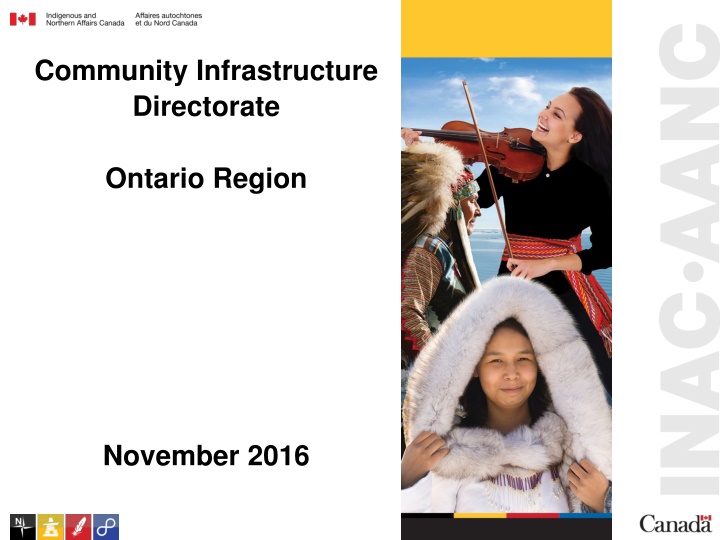
Historic Investments in Indigenous Communities for Infrastructure Development
The Budget 2016 outlines the Government of Canada's commitment to supporting Indigenous people by allocating funds for infrastructure, social, and health projects. The Ontario Region has made significant investments in water, wastewater, housing, education, and other community infrastructure to improve the living conditions of First Nations communities. Learn more about the progress and success of these projects as of November 2016.
Download Presentation

Please find below an Image/Link to download the presentation.
The content on the website is provided AS IS for your information and personal use only. It may not be sold, licensed, or shared on other websites without obtaining consent from the author. If you encounter any issues during the download, it is possible that the publisher has removed the file from their server.
You are allowed to download the files provided on this website for personal or commercial use, subject to the condition that they are used lawfully. All files are the property of their respective owners.
The content on the website is provided AS IS for your information and personal use only. It may not be sold, licensed, or shared on other websites without obtaining consent from the author.
E N D
Presentation Transcript
Community Infrastructure Directorate Ontario Region November 2016
Agenda Budget 2016 Investments Accessing Infrastructure Funding First Nation Infrastructure Investment Plan First Nation Water and Wastewater Enhanced Program Budget 2016 Housing Initiative Safe Drinking Water for First Nations Act Tripartate Water Working Group 2
Budget 2016 Investments The Government of Canada is making historic investments to support Indigenous people and communities across the country. $8.4 billion allocatedin the first five years of its mandate (2016/2017 2020/2021) to address infrastructure, social and health issues. Approximately $4 billion was committed by INAC to water and wastewater, housing, education and other community infrastructure on reserves: o $1.833B over five years for water and wastewater; o $416.6M over two years for housing; o $969.4M over five years for education facilities; o $331.9M over two years for other community infrastructure including cultural and recreation facilities; and o $408.9M over five years for solid waste management. 3
Budget 2016 Investments in Ontario As of the beginning of October, over $122 million has been set aside from Budget 2016 to address infrastructure needs in Ontario in the following five categories this fiscal year: o Water & Wastewater - $33.6 million o Housing - $61.9 million o Education Facilities - $12.8 million o Other Community Infrastructure - $12.3 million o Solid Waste Management - $1.5 million Ontario Region is providing First Nations with an additional $183.4 million in non-Budget 2016 funding for on-reserve infrastructure. 4
Budget 2016 Investments in Ontario contd Ontario Region has worked with First Nations to invest Budget 2016 allocations. As of October 17, 2016, successes include: o 21 water and wastewater projects are underway which will benefit more than 15,520 people; o 228 housing projects are underway which will benefit more than 82,420 residents; o 17 school project are in development to benefit more than 14,500 students; o Eight culture and recreation projects that will benefit more than 3,700 people; o Five energy, environment and connectivity projects that will benefit more than 4,900 people; o 10 community infrastructure projects for use by more than 16,670 people. 5
Accessing Infrastructure Funding Depending upon the type of infrastructure project a First Nation is pursuing, funding is accessed through a variety of INAC programs. INAC s Capital Management Officers (CMO) work with First Nations on planning for, and delivering infrastructure projects to, meet their community s needs, and advise and assist First Nations with the Department s processes for project approval and funding. Except for specialized funding programs, the first step to accessing infrastructure funding is the First Nations Infrastructure Investment Plan. 6
First Nation Infrastructure Investment Plan (FNIIP) The FNIIP is used to access proposal-based funding for infrastructure projects that First Nations wish to undertake in their communities. FNIIP submissions are used by departmental officials to plan and prioritize infrastructure investments in First Nation communities across Ontario Region. Projects vary in size and scope, and can include anything from a water treatment plant upgrade to multi-unit housing or a school. First Nations are sent letters, forms and instructions annually inviting them to submit their proposed infrastructure projects by the deadline of September 30th. The Plan is divided into two components: formula-funded and project-funded allocations. 7
FNIIP, contd Formula-Funded Allocations First Nations receive formula-based funding annually for the operation and maintenance of existing infrastructure assets, and for investing in new infrastructure under cost-sharing agreements. Two FNIIP types, depending upon funding agreements: o Block funding: the FNIIP is approved for a five-year period, but is reviewed and updated annually. Full core capital funding may be used for infrastructure needs eligible under the Capital Facilities Maintenance Program (CFMP). o Non-block funding: the FNIIP is reviewed and updated annually. The plan must outline expenditures to address Asset Condition Reporting System (ACRS) health and safety deficiencies first. The balance can be used for other CFMP needs. Block and non-block funding reviews begin during the first week of October, starting with the initial program overview, followed by a more detailed environmental review. 8
FNIIP, contd Proposal-Funded Allocations First Nations submit a list of community infrastructure project proposals requiring departmental funding. Projects are listed in order of importance or urgency to the First Nation s needs. Each project listed in the submission includes a concept description, outline of its rationale for funding, total estimated cost, cost-share amount or other sources of funding, as well as a cash-flow schedule. It is crucial to submit your plans outlining your proposal-funded activities as the Region uses them to plan their infrastructure expenditures, ranked according to need, for the coming fiscal year. 9
First Nation Water and Wastewater Enhanced Program (FNWWEP) This program provides funding to bring drinking water and wastewater operations in First Nation communities to a service level similar to those available to Canadians living in communities of similar size and location. FNWWEP funds feasibility studies, the design and construction of new or upgrades to existing water and wastewater treatment systems, as well as operator training and supports. First Nations do not apply to the program funds are available to support priority projects identified in the FNIIPs. Our immediate priority is to address long-term drinking water advisories in the Region. 10
Budget 2016 Housing Initiative Budget 2016 s housing initiative is proposal-based and national in scope, addressing the most pressing First Nations housing needs across the country. INAC sent a letter and information package to First Nations in May 2016, inviting them to identify their on-reserve housing infrastructure needs and submit funding applications by three deadlines: June 23, July 29 and September 30, 2016. In 2016-2017, INAC prioritized First Nation submissions using the criteria of remoteness, housing density, housing conditions and the number of community members on social assistance. The Government of Canada will engage with First Nation representatives over the coming year to develop an effective, sustainable and long-term approach to housing to adequately meet community needs on a continuous basis. 11
Budget 2016 Housing Initiative, contd 1. Immediate Needs Fund Focused on First Nations communities with high immediate needs for on-reserve housing. Funds are provided for new construction, renovation and lot servicing. Funding levels were made available in the information package sent to all First Nations, as well as the type of units eligible for funding. Eligible categories include: o Construction of multi-unit housing for social needs; o Renovation of band-owned (rental) housing and additions for vulnerable groups; and o Lot servicing. 12
Budget 2016 Housing Initiative, contd 2. Capacity Development Fund This fund focuses on helping First Nations increase their ability to oversee and manage their on-reserve housing. Eligible categories include: o Governance development and training to assist in community and infrastructure planning and the development of housing policies; o Home maintenance training for housing managers, staff and tenants; community education on tenant roles and responsibilities; preventing and addressing mould; establishing asset-lifecycle maintenance plans; and o Housing management tools, including: Training in construction and renovation planning and execution, operation of housing maintenance programs, and basic accounting; and Developing and managing an on-reserve housing inventory and maintaining a status and needs assessment. 13
Budget 2016 Housing Initiative, contd 3. Innovation Fund Encourages First Nation communities to pursue innovative approaches to on-reserve housing management and governance that benefit the entire community. Eligible categories include: o Developing or using new on-reserve housing governance structures/models, which includes but is not limited to: Creating a housing authority to manage, operate and administer funding and programs; Bringing housing service delivery under one entity/organization; and Supporting mentorship opportunities for those who want to receive or give mentoring training from/to another First Nation. o Alternative funding models to support on-reserve housing needs such as creating a revolving-loan fund or providing seed funding for the financing of home ownership. 14
Safe Drinking Water for First Nations Act (Bill S-8) The Safe Drinking Water for First Nations Act passed in 2013. As such, the Department was proceeding with developing corresponding regulations until a few months ago. The intent was to incorporate the provincial/territorial regulations that already exist in each region; but with adaptations to reflect on-reserve reality. The Act is part of the suite of previous legislation that is under review. 15
Tripartite Water Working Group We are addressing the pressing drinking water needs of Ontario Region First Nations by improving the infrastructure to produce that water. Our first priority is to fund projects in communities where the health and safety of residents are most at risk, i.e. those communities under long-term drinking water advisories. INAC, in partnership with the Ontario Ministry of the Environment and Climate Change and the Ontario First Nations Technical Services Corporation, are continuing to work at a technical level to track and identify opportunities to end drinking water advisories in Ontario. 16
Tripartite Water Working Group contd The initial meeting of the First Nation Water Trilateral Steering Committee was held in Thunder Bay on April 25, 2016, followed by subsequent meetings in May, September and October. Circuit Rider Training Program (CRTP) Ontario Region has completed a request for proposal process and has selected the Ontario First Nations Technical Services Corporation (OFNTSC) to deliver the Circuit Rider Training Program through to March 31, 2017. INAC regional officials have notified all First Nations and are working with OFNTSC to implement the program. 17
Transparency and Accountability We will work to provide you with updates and progress reports on our infrastructure spending. The regional Community Infrastructure Directorate team plans to attend as many events and large forums as possible to directly share infrastructure program information and listen to your feedback on our services, programs and procedures. We would appreciate and benefit from your insights and those of your operational/technical officials. Write, email, call, or reach out via your Tribal Council or PTO representatives, or speak to the Capital Management Officer assigned to work with your First Nation or Tribal Council. 18







